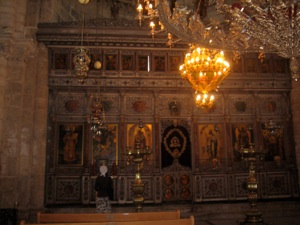Lod


Lod, the ancient city of Lydda (where in the New Testament Peter is held to have healed a paralytic man), is located 9 miles SE of Tel Aviv. It is thus in Israel proper. In ancient times Lod was a city of importance. There are the remains of Roman palaces and villas; a major mosaic from the 3rd century AD, 180 square metres in extent and not yet fully excavated, was discovered by chance in 1996. Also in the 3rd century St George, a pagan, soldier and commander of the Byzantine empire who was to become Christian, was born here to a Christian mother Lida (hence the name of the place). His last wish was to be buried in Lod, his body being brought there in 325. The cathedral, first built in the second century, rebuilt in the 11th century by the crusaders, destroyed by Saladin, and built in a third version in 1871, commemorates the town’s most famous son. From the 7th century the town was also an important Islamic city and has a delightful old mosque. There are four old wine presses dating from Ottoman times. There is, thus, a potential for a tourist industry: it is close to Tel Aviv airport.
With a total population of 75K Lod today has an extraordinary mix of communities: varied Arab communities (a large Bedouin community, a Christian Arab community, those who came from the West Bank), and a Jewish community (ultra-orthodox, religious and secular Jews; Jews who arrived in the 1950s, both Ashkenazi and Sephardic; and large Russian and Ethiopian communities). Lod is unusual in Israel in being a mixed Moslem/Jewish town (with a few Christians). Situated in the heart of this is the Lod Community Foundation, which exists to promote friendship and co-operation between the different peoples. The young man who heads it, whose field is social policy, was studying in London when - asked to come and found the community - he responded to the call; his fiancée studies in Oxford. The idea is that Lod should serve as a model of co-existence. A leadership programme gathers together young leaders from the different communities.
Lod is infamous for the fact that a major battle of the Israeli War of Independence, to Palestinians the time of the Nakba, was fought here in July 1948. The previous Palestinian inhabitants were driven back towards the West Bank and the Jordan. There are apparently 100,000 people living in the West Bank descended from those who came from Lod; belonging to a society of those who carry a key from Lod. The slaughter and devastation was such that the Israeli authorities closed the town for two years. Then in 1950 they destroyed everything in order to expunge the memory of what had happened. (The same was done in the case of Tiberius.) The town was 96% destroyed, thousands of Arab buildings being flattened. Previously settlement had been so dense that one could walk from roof to roof.
Today Lod is one of the poorest places in Israel. One might well say that the place is a tip. For many years the town had no government to speak of, the last mayor having been a crook. There are no social services. The community centre is closed. There is a high level of violence, the different communities blaming one another. The town government possesses neither the political will nor the budget to do anything. There is no town planning. House prices are the lowest in Israel. The different communities live in separated neighbourhoods. There are poor Arabs, poor Ethiopians, and poor Jews: approximately 95% of the population is poor. The whole Arab part of the town has been built illegally, the people there paying no taxes (since officially it doesn’t exist) and there are no services. A wide ditch is used to dump sewage. The train station is the largest in Israel. It has no underground pass and no bridge; people are regularly killed or wounded there. What more can one say? The leader of the Community speaks of the gap between the potential and the present reality.


Old synagogue (foreground); mosque (rear)
The Christian Cathedral
Wine press dating from the Ottoman era



Sewage ditch
Lod today